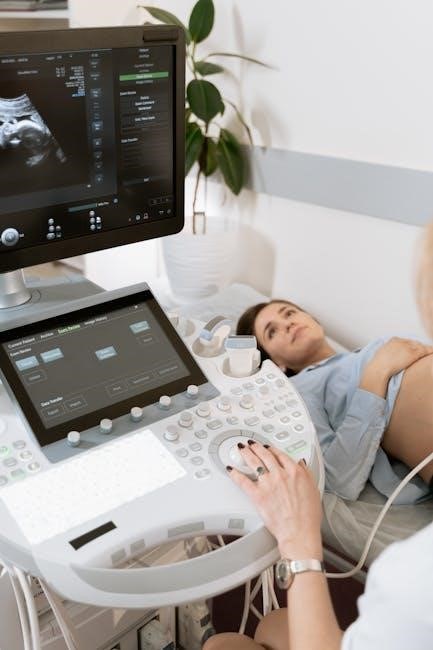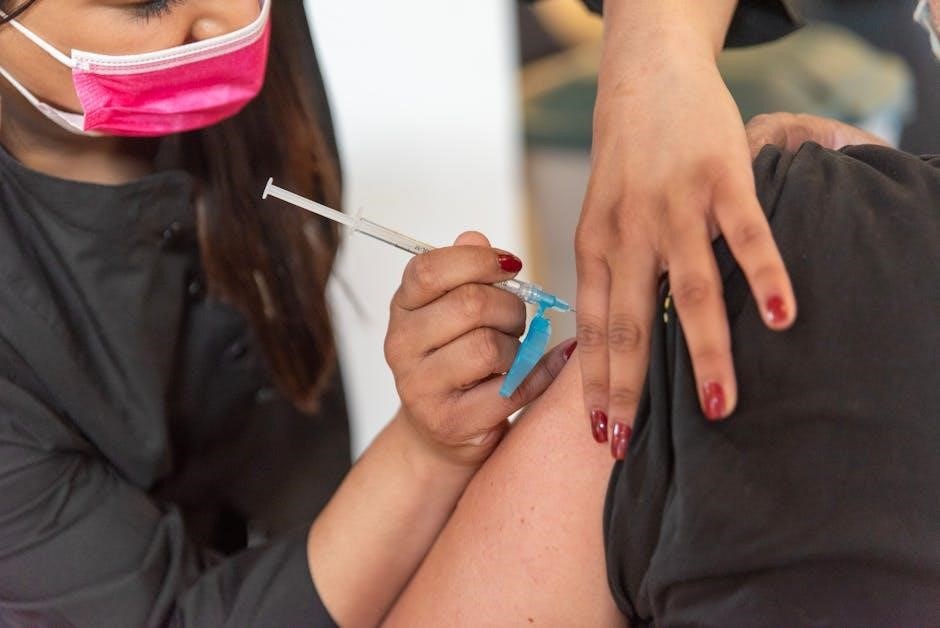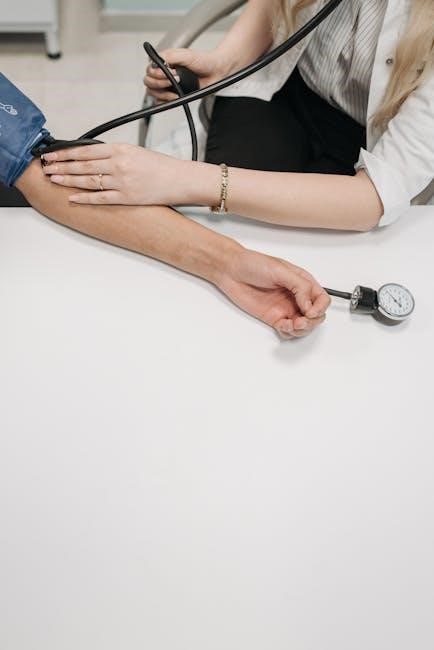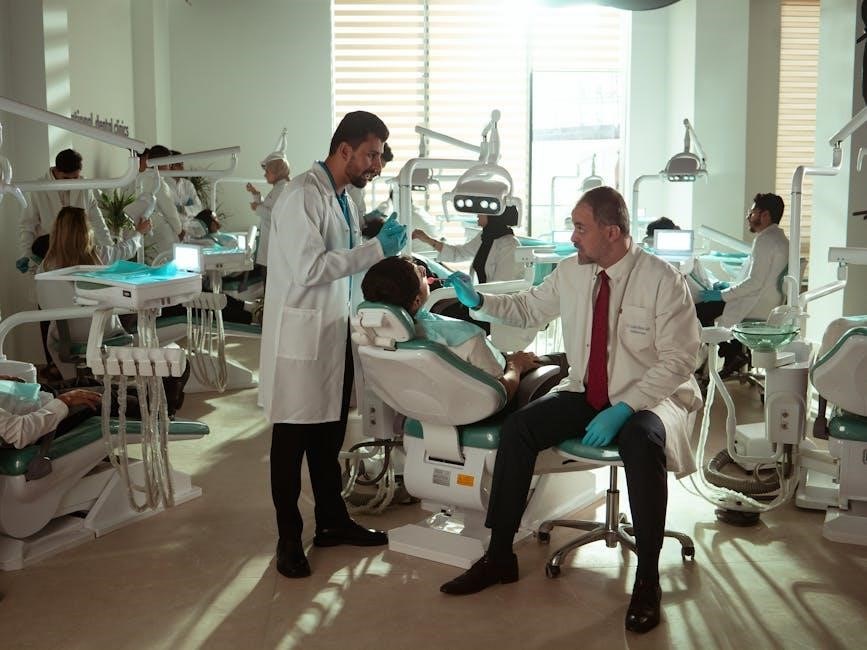Meralgia paresthetica is a nerve disorder causing burning pain, tingling, and numbness in the outer thigh due to nerve compression. This guide provides detailed information and expert advice for managing symptoms and treatment options.
1.1 What is Meralgia Paresthetica?
Meralgia paresthetica is a neurological condition caused by compression of the lateral femoral cutaneous nerve, which supplies sensation to the outer thigh. It leads to symptoms like burning pain, tingling, and numbness in the affected area. This condition is often associated with nerve entrapment due to factors like obesity, diabetes, or tight clothing. It does not involve motor nerve damage, making it primarily a sensory disorder. The name derives from Greek words meaning “painful nerve,” accurately describing its characteristic symptoms.
1.2 Overview of the Condition

Meralgia paresthetica is a neurological condition characterized by discomfort along the outer thigh due to nerve compression. It often results from prolonged pressure on the lateral femoral cutaneous nerve, typically caused by tight clothing, obesity, or prolonged standing. Symptoms are usually localized and may worsen with activity. While not life-threatening, it can significantly impact daily life. Treatment focuses on addressing underlying causes and managing symptoms. Early intervention often leads to improvement, though some cases may require extended management to achieve full relief.

Causes and Risk Factors
Meralgia paresthetica results from compression of the lateral femoral cutaneous nerve. Risk factors include obesity, diabetes, pregnancy, tight clothing, and prolonged standing or sitting.
2.1 Nerve Compression and Its Role
Nerve compression is the primary cause of meralgia paresthetica. The lateral femoral cutaneous nerve, which supplies sensation to the outer thigh, becomes compressed, often near the inguinal ligament. This compression disrupts normal nerve function, leading to pain, numbness, and tingling. The nerve may be pinched due to tight spaces, inflammation, or external pressure. Understanding this mechanism is crucial for developing effective treatment strategies to relieve symptoms and restore normal nerve function.
2.2 Obesity as a Contributing Factor
Obesity is a significant risk factor for meralgia paresthetica. Excess body weight increases pressure on the lateral femoral cutaneous nerve, particularly near the inguinal ligament. This compression is often exacerbated by the distribution of fat around the abdomen, which can further restrict nerve mobility. Additionally, obesity may contribute to inflammation and reduced nerve flexibility, worsening symptoms. While not the sole cause, maintaining a healthy weight can significantly reduce the likelihood of developing or worsening meralgia paresthetica.
2.3 Diabetes and Its Impact
Diabetes can contribute to meralgia paresthetica by affecting nerve health. High blood sugar levels damage nerves over time, increasing the risk of neuropathy. This nerve damage can predispose individuals to conditions like meralgia paresthetica, as the lateral femoral cutaneous nerve becomes more susceptible to compression. Managing blood sugar levels is crucial to prevent further nerve damage and reduce the likelihood of developing symptoms. Proper diabetes control may also help alleviate existing symptoms of meralgia paresthetica.
2.4 Pregnancy and Hormonal Changes
Pregnancy can contribute to meralgia paresthetica due to physical and hormonal changes. As the uterus expands, it may compress nerves in the pelvic area, including the lateral femoral cutaneous nerve. Additionally, hormonal fluctuations during pregnancy can increase nerve sensitivity. Weight gain and altered posture may also exacerbate nerve compression. Symptoms often resolve after pregnancy, but managing discomfort during this time is important. Conservative treatments are typically recommended to avoid risks associated with medication or surgery during pregnancy.
2.5 Tight Clothing or Accessories
Tight clothing or accessories, such as belts, waistbands, or shapewear, can compress the lateral femoral cutaneous nerve, contributing to meralgia paresthetica. This compression is more likely in individuals who wear restrictive garments regularly. The constant pressure on the nerve can irritate it, leading to symptoms like burning pain or numbness in the thigh. Avoiding tight clothing and opting for loose, comfortable attire can help reduce nerve compression and alleviate discomfort. This is a common and preventable contributing factor, especially in professions or lifestyles involving tight waistbands.

Symptoms of Meralgia Paresthetica
Meralgia paresthetica causes burning pain, tingling, numbness, and increased sensitivity in the thigh. Patients may also experience a crawling skin sensation.
3.1 Burning Pain in the Thigh
Burning pain in the thigh is a hallmark symptom of meralgia paresthetica. It typically occurs on the outer or lateral aspect of the thigh and may radiate downward. The pain can be sharp, achy, or searing and often worsens with activities like walking, standing, or prolonged sitting. It may also intensify when wearing tight clothing or accessories that compress the nerve. Some patients describe the pain as intermittent, while others experience it continuously, significantly impacting daily activities and quality of life.
3.2 Tingling and Numbness
Tingling and numbness are common symptoms of meralgia paresthetica, often accompanying the burning pain. These sensations typically affect the outer thigh and may feel like pins and needles or a loss of sensation. They can be triggered by standing, walking, or prolonged pressure on the nerve. Some patients report intermittent numbness, while others experience it more consistently. This symptom can interfere with daily activities and may cause discomfort, especially when combined with pain. It is essential to address these sensations to prevent further nerve irritation or complications.
3.3 Increased Sensitivity to Touch
In meralgia paresthetica, increased sensitivity to touch is a frequent complaint. Even light contact, such as clothing brushing against the skin, can cause discomfort or irritation. This heightened sensitivity often affects the outer thigh and may lead to avoidance of certain fabrics or tight clothing. Patients may find it challenging to tolerate direct pressure or even gentle touch in the affected area. Managing this symptom often involves avoiding tight clothing and minimizing direct pressure on the nerve to reduce discomfort and prevent exacerbation of the condition.
3.4 Crawling Sensation on the Skin
A crawling sensation on the skin, known as paresthesia, is a common symptom of meralgia paresthetica. Patients often describe it as an uncomfortable, pins-and-needles-like feeling on the outer thigh. This sensation can occur spontaneously or be triggered by light touch or movement. It is caused by irritation or compression of the lateral femoral cutaneous nerve. While not painful, this sensation can be distressing and may interfere with daily activities. Managing the underlying nerve compression can help alleviate this symptom and improve overall comfort for patients.

Diagnosis and Evaluation
Diagnosis involves a thorough clinical examination, patient history review, and physical tests to assess nerve function. Imaging may be used to confirm nerve compression or rule out other conditions.
4.1 Clinical Examination
A clinical examination for meralgia paresthetica involves a physical assessment and review of the patient’s medical history. The healthcare provider will evaluate the distribution of symptoms, such as pain or numbness, and perform specific tests. Tinel’s sign, which involves tapping the nerve, and the reverse straight leg raise test may be used to identify nerve compression. The doctor may also assess sensory changes in the affected thigh. These steps help confirm the diagnosis and rule out other conditions with similar symptoms, ensuring an accurate assessment.
4.2 Diagnostic Tests and Imaging
Diagnostic tests for meralgia paresthetica may include imaging studies like MRI or ultrasound to visualize the compressed nerve and surrounding tissue. Electromyography (EMG) can assess nerve function and identify abnormalities. X-rays may rule out other causes of thigh pain, such as fractures or arthritis. In some cases, a nerve conduction study is performed to measure the nerve’s response. These tests help confirm the diagnosis and rule out other conditions, ensuring an accurate assessment of the patient’s condition and guiding appropriate treatment.

Treatment Options
Treatment focuses on relieving symptoms and addressing the root cause, often involving a combination of rest, physical therapy, pain-relieving medications, and lifestyle adjustments. Surgery is rarely needed.
5.1 Conservative Management
Conservative management is the first line of treatment for meralgia paresthetica, focusing on alleviating symptoms without invasive procedures. This includes rest, avoiding activities that worsen symptoms, and weight loss if obesity is a contributing factor. Physical therapy can help improve posture and reduce nerve compression. Over-the-counter pain relievers, such as NSAIDs, may be recommended to reduce discomfort. In some cases, local anesthetic injections or corticosteroids can provide temporary relief. Lifestyle modifications, such as wearing loose clothing, are also essential. Most patients experience improvement with these measures within a few months.
5.2 Physical Therapy and Exercises
Physical therapy plays a crucial role in managing meralgia paresthetica, focusing on exercises that relieve nerve compression and improve mobility. Gentle stretching of the hip flexors and abdominal muscles can help reduce tightness. Strengthening exercises for core and gluteal muscles may also be recommended to enhance stability. Postural exercises are often included to reduce pressure on the lateral femoral cutaneous nerve. Low-impact activities, such as swimming or cycling, are encouraged to maintain fitness without aggravating symptoms. A physical therapist can tailor a program to address individual needs and promote recovery.
5.3 Medications for Symptom Relief
Medications can help alleviate symptoms of meralgia paresthetica. Over-the-counter pain relievers, such as NSAIDs (e.g., ibuprofen or naproxen), can reduce pain and inflammation. In some cases, neuromodulator medications like gabapentin or pregabalin may be prescribed to address nerve-related pain. Muscle relaxants might also be recommended to ease discomfort. For severe cases, corticosteroid injections may be considered to reduce inflammation around the nerve. Always consult a healthcare provider before starting any medication to ensure the best treatment plan for your condition.
5.4 Surgical Intervention
Surgical intervention is typically reserved for severe cases of meralgia paresthetica when conservative treatments fail. The procedure often involves nerve decompression to relieve pressure on the lateral femoral cutaneous nerve. In some cases, neurectomy (nerve removal) may be performed. Surgery can provide significant relief for patients with persistent symptoms. However, it carries risks like infection, bleeding, and prolonged recovery. Success rates are high, but it’s important to discuss the benefits and risks with a healthcare provider to determine if surgery is the appropriate course of action.

Lifestyle Modifications
Lifestyle changes, such as maintaining a healthy weight, wearing loose clothing, and avoiding prolonged standing, can help alleviate symptoms and prevent worsening of meralgia paresthetica.
6.1 Weight Management
Maintaining a healthy weight is crucial for managing meralgia paresthetica, as excess weight can increase pressure on the lateral femoral cutaneous nerve. A balanced diet rich in fruits, vegetables, and whole grains, combined with regular exercise, can help achieve and maintain a healthy weight. Even modest weight loss can reduce nerve compression and alleviate symptoms. Consulting a healthcare provider or nutritionist can provide personalized guidance for sustainable weight management, improving both symptom relief and overall health outcomes for patients with meralgia paresthetica.
6.2 Avoiding Tight Clothing
Avoiding tight clothing is essential for managing meralgia paresthetica, as tight fabrics can compress the lateral femoral cutaneous nerve. Opt for loose, comfortable clothing made from breathable materials to reduce pressure on the nerve. Avoid tight belts, skinny jeans, or any accessories that constrict the waist or thigh area. By minimizing external pressure, patients can prevent further irritation and alleviate symptoms. This simple adjustment is a key lifestyle modification for improving comfort and managing the condition effectively.

6.3 Activity Modification
Modifying daily activities is crucial for managing meralgia paresthetica symptoms. Avoid prolonged standing, repetitive hip flexion, and tight clothing that compresses the nerve. Consider low-impact exercises like swimming or cycling with proper adjustment to reduce thigh pressure. Take regular breaks to stretch and move if your job involves standing or sitting for long periods. Gentle stretching and yoga can help relieve tension without aggravating the condition. Consulting with a physical therapist can provide personalized activity plans tailored to your specific needs and symptoms.

Prognosis and Recovery
Meralgia paresthetica often improves with conservative treatments. Recovery time varies, typically lasting weeks to months. Factors like lifestyle changes and treatment adherence significantly influence outcomes. Proper management can lead to complete symptom resolution or significant relief, improving quality of life for most patients. Persistent cases may require ongoing care or further intervention. Early diagnosis and treatment are key to optimal recovery and minimizing long-term discomfort or complications. Regular follow-ups with healthcare providers ensure tailored care and support throughout the healing process. With appropriate measures, many patients achieve full recovery and resume normal activities without lingering symptoms. Consistency in treatment and lifestyle adjustments play a crucial role in achieving and maintaining remission. Patients should remain proactive in managing their condition to prevent recurrence and promote overall well-being. Understanding the condition and adhering to medical advice can significantly enhance recovery outcomes and reduce the risk of future episodes. Maintaining a healthy weight, avoiding nerve compression, and staying active are essential for long-term management and preventing relapse. Timely medical intervention and patient commitment are vital for effective recovery and improving prognosis. By addressing underlying causes and adopting preventive measures, individuals can effectively manage meralgia paresthetica and enjoy a better quality of life. Recovery is highly individualized, and patience is important as the body heals and responds to treatment. Collaborating with healthcare professionals ensures personalized care and the best possible outcomes for each patient. Overall, the prognosis for meralgia paresthetica is positive, with most patients experiencing significant improvement or complete resolution of symptoms with proper care and attention.
7.1 Expected Outcomes
Most patients with meralgia paresthetica experience significant improvement in symptoms within a few months of treatment. Complete resolution of pain and numbness is common, especially with early intervention. Some individuals may have mild residual symptoms but can manage them effectively. Recovery outcomes depend on factors like treatment adherence, lifestyle changes, and underlying health conditions. Weight management and avoiding nerve compression can enhance long-term results. Overall, the prognosis is favorable, with most patients achieving substantial relief and improved quality of life.
7.2 Recovery Time and Factors Affecting It
Recovery time for meralgia paresthetica varies, typically ranging from weeks to months. Factors influencing recovery include the severity of nerve compression, adherence to treatment, and underlying health conditions. Weight loss and avoiding nerve irritation can accelerate healing, while untreated cases may lead to prolonged symptoms. Lifestyle modifications and early intervention significantly improve outcomes. Patients with diabetes or obesity may experience slower recovery, emphasizing the importance of managing these conditions. Consistent follow-up and proper care can ensure optimal healing and prevent recurrence.

Patient Resources
A downloadable PDF guide provides comprehensive insights, while references offer further reading. These resources help patients understand and manage meralgia paresthetica effectively.
8.1 Downloadable PDF Guide
A downloadable PDF guide on meralgia paresthetica provides patients with detailed information on symptoms, diagnosis, treatment options, and lifestyle modifications. It includes illustrations, self-care tips, and a list of frequently asked questions to help patients better understand their condition. The guide is designed to be user-friendly, offering practical advice for managing symptoms and improving quality of life. It serves as a valuable resource for both patients and caregivers, ensuring they are well-informed and empowered to take an active role in their care.
8.2 References and Further Reading
For deeper understanding, patients can explore reputable medical websites like Mayo Clinic or PubMed for detailed articles on meralgia paresthetica. Academic journals such as Neurology offer in-depth studies, while organizations like the American Academy of Neurology provide evidence-based guidelines. These resources enhance knowledge and offer diverse perspectives, aiding in informed decision-making and comprehensive care.
Meralgia paresthetica is a manageable condition when properly diagnosed and treated. Early intervention, lifestyle adjustments, and medical care can significantly improve symptoms and quality of life. Patients are encouraged to seek professional advice and adhere to recommended therapies. With appropriate management, most individuals experience relief and resume normal activities. Regular follow-ups ensure long-term well-being, emphasizing the importance of a collaborative approach between patients and healthcare providers.



